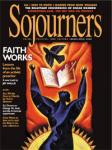1) True or false: Given a homework assignment to prepare a written report on a topic of choice, a student may write a paper on his or her religious beliefs.
2) True or false: Given a required oral presentation in the classroom, a student may express his or her religious beliefs and close with prayer.
As the United States has become a more religiously diverse society and expressions of religious faith a more significant part of public life, these type of questions are increasingly being faced by public schools. How can schools protect the rights of students to exercise their faith while avoiding any official support of religious activities?
This dual objective has often led to one of two extremes—either school administrators have unduly restricted religious expression or improperly imposed it. The proper role of religion in the schools has been the topic of frequent litigation. But there is a middle ground—one which can serve both purposes.
President Clinton and Secretary of Education Richard Riley recently issued revised guidelines for "Religious Expression in Public Schools," offering administrators, parents, and students a set of principles to provide for free religious expression by students and to maintain freedom from government-sponsored religion. The guidelines, said Secretary Riley, are to ensure that "Public schools can neither foster religion nor preclude it. Our public schools must treat religion with fairness and respect and vigorously protect religious expression as well as the freedom of conscience of all other students."
Covering such areas as student prayer, religious activities, teaching about religion, distribution of religious literature, and expressions of faith in homework assignments, the guidelines track recent court decisions. (For the questions above, the answers are 1) true—written assignments are protected, and 2) false—students are a "captive audience" who cannot be forced to listen to religious expression.)
In addition, the president proposed new guidelines for the involvement of churches and faith-based organizations in partnership with public schools. Around the country, such groups are increasingly involved in tutoring, mentoring, and after-school programs with schools. The administration is encouraging these partnerships, but cautions that school administrators must remain neutral among organizations, select students without regard to their religious beliefs, and protect students’ right not to participate in religious activities.
THIS FALL A DIVERSE group of religious and educational organizations—the National Association of Evangelicals, National Education Association, American Jewish Committee, Christian Legal Society, People for the American Way, and a number of others—issued a statement on "The Bible and Public Schools." It is the first time that such a varied assortment of groups has agreed on principles about teaching the Bible.
Expressing a desire that "public schools protect the religious liberty rights of students" and that "the curriculum include study about religion as an important part of a complete education," the statement focused on the Bible "because of the need to address the conflicts and confusion surrounding the Bible in the public school curriculum." It urges that local school boards adopt policies on the study of religion so that teachers clearly understand what they can and cannot teach.
The core of the principles is that schools may teach about the Bible as history, as literature, as part of a world religions course—but may not have a devotional approach, and may not impose, discourage, or encourage any particular view. Teachers of such courses are encouraged to have a background in the academic study of religion, including a course in religious studies as part of their certification.
The statement notes that "Because religion plays a significant role in history and society, study about religion is essential to understanding both the nation and the world. Knowledge of the roles of religion in the past and present promotes cross-cultural understanding in our increasingly diverse society."
These two statements are a welcome effort, by government and private organizations, to chart a path between the extremes. Allowing students to learn about religions—their own and others—can only lead to a greater understanding of diverse beliefs. Allowing students to express their religious views without imposing them on others of different or no religion can only lead to greater respect.
If sensible guidelines can be implemented so that students feel neither harassed nor proselytized, their educational experience will be richer and fuller. And if tolerance and respect for others is consistently taught, our society will be stronger and more civil.
DUANE SHANK is executive assistant and director of outreach at Sojourners.

Got something to say about what you're reading? We value your feedback!